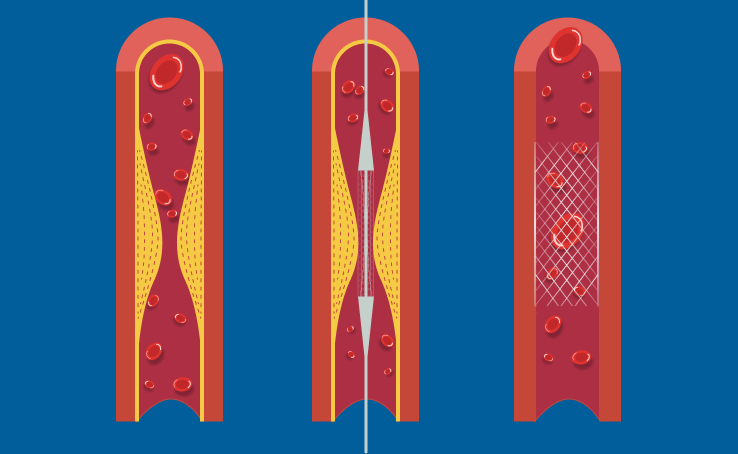Avg Price: $ 2500 -$ 8500


Treatment Time
Recovery Time
Hospitalization Days
Success Rate
Coronary Heart Disease (CHD) plays a substantial role in both global mortality and health-related challenges. According to a report by the World Health Organization (WHO) in 2005, Cardiovascular Disease (CVD) was accountable for 17.5 million deaths, making up 30% of the total 58 million deaths worldwide. Over the last two decades, there has been a worrisome increase in the incidence of cardiovascular diseases particularly Coronary Artery Disease (CAD) and deaths related to it in countries like India and other nations in South Asia. The occurrence of Coronary Artery Disease (CAD) among Indians residing in India is 21.4% for individuals with diabetes and 11% for those without diabetes.
This emphasizes the need for therapeutic alternatives like angioplasty and the stent placement. These medical interventions have been hailed as a blessing within the cardiovascular domain, owing to their substantial merits in managing Coronary Artery Disease (CAD) and enhancing the holistic quality of life for individuals.
In the span of one year in 2018, approximately 438,351 angioplasties were conducted in India, reflecting a growth rate of 13.14% compared to the data from 2017, and these procedures utilized 578,164 coronary stents. This rise in numbers could potentially be attributed to the higher prevalence of coronary artery disease, the establishment of angioplasty facilities in tier 2 cities, greater accessibility to affordable stents, reduced costs, increased awareness among the general populace, and a higher count of interventional cardiologists across the nation. More than 47% of these interventions were carried out in centers with substantial caseloads, while only 4.42% of centers were responsible for performing nearly 27% of the total angioplasty procedures.
Therefore, with the progressing time, the effort to find the best doctor for angioplasty and stent placement and the best hospital for angioplasty and stent placement in India is progressively becoming more convenient and financially feasible.
Angioplasty refers to a technique aimed at widening constricted or obstructed blood pathways responsible for delivering blood to the heart, specifically the coronary arteries.
A Coronary Artery Stent is a tiny metallic mesh conduit that enlarges within a coronary artery. Often, a stent is introduced concurrently with or directly following angioplasty. Its purpose is to avert the re-narrowing of the artery. A drug-eluting stent includes medication within it, which aids in preventing prolonged closure of the artery.
Arteries have the potential to undergo constriction or obstruction due to accumulations referred to as plaque. Plaque is composed of fat and cholesterol that gathers on the interior walls of arteries. This phenomenon is termed as atherosclerosis or the hardening of arteries. When atherosclerosis impacts the Arteries responsible for transporting blood to the heart muscle, it is termed as Coronary Artery Disease, abbreviated as CAD. This condition stands as the primary cause of death among Americans.
Angioplasty can be employed for the purpose of addressing:
Coronary Artery Disease, referred to as CAD, can be addressed through Coronary Angioplasty, also known as percutaneous Coronary Intervention. This procedure becomes beneficial when you have a Coronary Artery that is narrowed or obstructed, impeding your heart's access to necessary oxygen. This condition can cause chest pain and potentially trigger a heart attack.
Not all blockages warrant or are suitable for treatment via angioplasty. Individuals with multiple blockages or blockages in specific locations might require coronary bypass surgery. Additionally, some blockages are managed using medical therapies rather than an interventional procedure.
Take Charge of Your Health
Book a Free Consultation

There exist two primary categories of Angioplasty:
Balloon angioplasty: It entails the application of an inflating balloon's pressure to clear the plaque obstructing an artery. This approach is seldom employed alone, except in situations where stent placement is not feasible in the necessary position.
Stent Angioplasty: It is insertion of a stent into the artery, employing a wire mesh tube referred to as a stent. Stents serve the purpose of preventing a recurring narrowing of the artery subsequent to angioplasty. Research data from 2018 approximates that medical practitioners in the United States implant more than 1.8 million stents annually.
Coronary Stents can be categorized into several types based on their composition, design, and properties. The main types of Coronary Stents include:
Bare Metal Stents (BMS): These stents are made of metal, usually stainless steel or similar materials. They are designed to provide structural support to the artery and keep it open after angioplasty. BMS do not have any special coatings or medications.
Drug-Eluting Stents (DES): These stents are coated with medications that are slowly released into the surrounding tissue after stent placement. These medications help inhibit the growth of scar tissue within the stent, reducing the risk of re-narrowing (restenosis) of the artery. DES are effective in reducing the need for repeat procedures. At present, DES are predominantly utilized, with limited use of bare metal stents.
Bioabsorbable Stents: Also known as bioresorbable stents, these stents are designed to gradually dissolve and be absorbed by the body over time. They provide temporary support to the artery, releasing medication as they dissolve. The advantage is that there is no permanent implant left behind, which might be beneficial for some patients.
The pre-evaluation is pivotal for ascertaining the appropriateness of Angioplasty and Stent Placement as a viable approach and for mitigating possible risks in the perioperative and postoperative periods. Below is an overview of the pre-evaluation process:
Your Health is Our Priority
Book a Free Consultation
The typical course of Angioplasty generally proceeds as follows:
Angioplasty is generally considered safe, but its important to discuss potential complications with your doctor. The risks associated with Angioplasty and Stent placement encompass:

After the procedure, you might either be taken to a recovery room for observation or brought back to your hospital room. You'll be required to lie flat in bed for several hours. A nurse will be in charge of monitoring your vital signs, the area where the catheter was inserted, and the circulation and sensation in the arm or leg that was treated.
If you experience any chest pain, tightness, discomfort, warmth, bleeding, or pain at the insertion site, its crucial to notify your nurse promptly. The duration of bed rest can range from 2 to 6 hours, depending on your individual condition. If your doctor used a closure device, your bed rest might be shorter.
In certain cases, the sheath or introducer may remain in the insertion site. In this situation, you will need to stay in bed until the sheath is removed. Once the sheath is taken out, you might be allowed a light meal. You may feel the need to urinate frequently due to the effects of the contrast dye and increased fluid intake. While on bed rest, you will use a bedpan or urinal to avoid bending your treated limb.
Once the prescribed bed rest time is over, you can get out of bed. The nurse will assist you the first time and check your blood pressure while you're lying down, sitting, and standing. It's advisable to move slowly when getting up to prevent dizziness from the prolonged bed rest. If you experience pain or discomfort at the insertion site or due to lying flat for an extended period, you might receive pain medication. Drinking water and other fluids is encouraged to help eliminate the contrast dye from your system.
You can generally return to your regular diet after the procedure, unless otherwise directed by your doctor. Expect to spend the night in the hospital after the procedure. Depending on your condition and the results of the procedure, your stay might be extended. You will receive comprehensive instructions for your discharge and recovery period.
When at home, monitor the insertion site for bleeding, unusual pain, swelling, changes in color, or temperature. Minor bruising is normal. However, if you notice consistent or excessive bleeding that can't be managed with a small dressing, inform your healthcare team.
If a closure device was used, you'll receive specific guidance on caring for the site. A small knot or lump beneath the skin is normal and should gradually subside over a few weeks. It's essential to keep the insertion site clean and dry. Your healthcare team will provide bathing instructions. Typically, you should avoid bathtubs, hot tubs, and swimming until the skin has healed. You might be advised to avoid strenuous activities. Your healthcare team will inform you about when you can return to work and resume regular activities.
Inform your healthcare team if you experience any of the following:
Avail the Expert Health Advice
Book a Free Consultation
The period of recuperation after the procedure can indeed be extended, allowing the body to gradually restore its vitality. Its crucial for patients to consistently make progress day by day and integrate certain supplementary measures. Here are a few lifestyle modifications to embrace after experiencing an Angioplasty:
Typically, Coronary Angioplasty and Stent Placement enhance the circulation within the treated artery. A significant number of individuals witness an improvement in their symptoms, enabling them to engage in more activities. It demonstrates a success rate ranging between 85% and 90%.
Occasionally, the Artery may experience a re-narrowing (restenosis), leading to angina symptoms. However, continuous advancements in stent technology have diminished the likelihood of this occurrence. As a result, a considerable portion of individuals experience extended periods without symptoms.
Medical expenses in India are budget-friendly, with the cost varying from ₹ 66808 ($839) to ₹ 134573 ($1690), contingent on your geographical location and hospital preference. If you're unable to bear steep expenses or lack insurance coverage, there exists a viable economical alternative. Consider exploring the option of undergoing an angioplasty in India. India's healthcare system capitalizes on decreased labor and infrastructure costs, enabling healthcare establishments to furnish services at more affordable prices. Moreover, the presence of proficient medical experts combined with a competitive market cultivates economically efficient approaches. Additionally, India's thriving pharmaceutical sector frequently manufactures generic drugs, which contributes to a decrease in the overall cost of treatment. Numerous accredited hospitals provide these services at notably lower costs than anticipated.
| Location | Minimum Cost ($) | Average Cost ($) | Maximum Cost ($) |
| Delhi | $ 3500 | $ 5000 | $ 8000 |
| Mumbai | $ 3500 | $ 5000 | $ 8000 |
| Chennai | $ 2500 | $ 5500 | $ 8500 |
| Hyderabad | $ 3500 | $ 5000 | $ 8000 |
The expenses associated with the preliminary assessments and examinations conducted prior to the Angioplasty and Stent Placement might cover various diagnostic procedures. These additional charges encompass tests such as X-rays, CT scans (computed tomography), MRI scans (magnetic resonance imaging), pulmonary function tests (PFTs), carotid doppler/ultrasound studies (carotids), ankle-brachial index (ABIs), surface echocardiograms (Echo), vein mapping, trans-esophageal echocardiograms (TEE), ECG-gated SPECT myocardial perfusion imaging (stress test), heart catheterization (Cath), cardiac magnetic resonance imaging (MRI), and other diagnostic evaluations. The total expenses for these tests can vary between INR 1,00,000 and INR 1,50,000.
Nonetheless, the cost of Angioplasty and Stent Placement in India might fluctuate contingent on the subsequent key aspects:
MedFlick, your trusted healthcare companion, is dedicated to ensuring that your medical journey goes as smoothly and successfully as possible.
Fostering expertise backed by commitment, resilience and years of experience, we connect you to a wide network of India's best doctors
Explore the most advanced, reputable and trusted hospitals in India, offering the highest levels of clinical and surgical excellence

The worlds most trusted personalized health community with more than 1,00, 000 members that share their journey, experiences and health insights. Join your community and get access to make informed health decisions.
Explore



